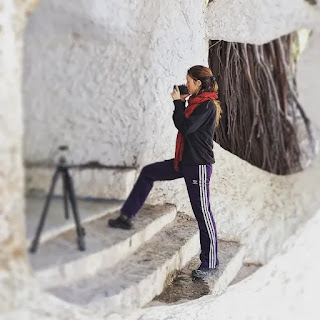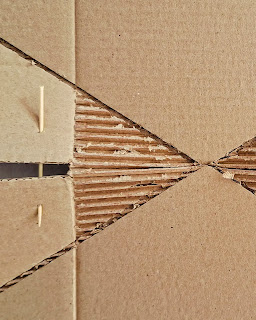Intenté mostrar el singular trazado en damero y el paisaje de La Plata a través de dos formas de expresión: la pintura y la instalación. En los cruces de las calles principales se extienden amplios parques y plazas, complementados por altísimos árboles al borde de la calle y algunos edificios de estilo europeo, que dan crédito a su apodo de «Ciudad Forestal» y muestran su rico patrimonio histórico y cultural. El título de la exposición combina «Root» (raíz) y «heartbeat» (latido del corazón), dando a entender la vitalidad de las raíces de los árboles bajo tierra, reflejando la actividad rítmica del latido del corazón humano y demostrando una fuerza estable y sostenida. Todos los días realizaba inspecciones caminando la ciudad, descubriendo sus estilos y cualidades enormemente diferentes durante el día y la noche. De día, el cálido sol de abril y la suave brisa otoñal añaden un toque de belleza al paisaje urbano. El juego de sombras verdes sobre los edificios y las capas de ramas que dividen el cielo azul crean una escena pintoresca. La suave luz se filtra por los huecos entre ramas y hojas, formando a veces una etérea niebla, a veces un suave enredo. Al caer la noche, los colores vibrantes y las luces cobran vida, y cada negocio parece una caja de luz, atrayendo a los transeúntes con sus vidrieras iluminadas. La cultura de la “cena tardía” en Argentina se extiende por las calles bañadas por el cálido resplandor de las farolas, donde se puede ver a clientes mezclándose en un ambiente pausado de copas que tintinean. A pesar de las cautivadoras escenas, es difícil ignorar las irregulares veredas bajo los pies. La vitalidad oculta de los árboles al borde irrumpe a través de las baldosas fracturadas y las raíces enredadas parecen no estar dispuestas a dejarse confinar por las rejillas reguladas. Es fácil imaginar el derrumbamiento de los edificios en la superficie dentro de cien años, mientras estos árboles frondosos y profundamente enraizados parecen dispuestos a relevarlos. A través de la presentación espacial de la pintura y la instalación, pretendía mostrar mis experiencias visuales y percepciones corporales desde diversas perspectivas, con el «latido» y el «pulso» de las raíces de los árboles como principales imágenes. La disposición de los cuadros no sólo apunta a la distribución espacial de la ciudad, sino que también utiliza pintura acrílica fluida de color seda para representar los diversos cambios de los objetos refractados por la luz. La instalación, inspirada en el concepto de las cajas de luz, presenta una retícula que regula el crecimiento de los árboles de la calle, con un nudo de tela de «corazón» de caligrafía china en el centro. Sus líneas fluidas se asemejan a raíces enredadas, indicando que el «corazón del árbol» es donde opera la vitalidad. En el ciclo del día y la noche, los troncos pueden seguir creciendo sin cesar hacia arriba, y las ramas y las hojas florecen, todo ello basado en el incesante «pulso» de Rootbeat. En general, Rootbeat surge de la experiencia del especial paisaje urbano de La Plata, la sutil conexión entre los árboles y la tierra y la vitalidad mostrada por la interconexión de las raíces, al igual que la vibrante y enérgica gente que bulle sobre la superficie.
ENG
I attempted to showcase the unique checkerboard layout and landscape of La Plata through two forms of expression: painting and installation. At the main street intersections, expansive parks are spread out, complemented by towering roadside trees and European-style buildings, giving credence to its nickname as the "Forest City" and showcasing its rich historical and cultural heritage. The exhibition title, Rootbeat, combines "Root" and "heartbeat," implying the vitality of tree roots underground, mirroring the rhythmic activity of a human heartbeat, and demonstrating a stable and sustained force. Every day, I conducted on-foot surveys of the city, discovering its vastly different styles and qualities during day and night. In the daytime, the warm April sun and gentle autumn breeze add a touch of beauty to the cityscape. The interplay of green shadows on the buildings and the layers of branches dividing the blue sky create a picturesque scene. Soft light filters through the gaps between branches and leaves, sometimes forming an ethereal mist, sometimes a gentle entanglement. As night falls, vibrant colors and lights come alive, with each shop appearing like a lightbox, enticing passersby with its illuminated storefronts. The culture of "late dining" in Argentina spills onto the streets bathed in the warm glow of streetlights, where one can see customers dressed in fancy attire mingling with a leisurely atmosphere of clinking glasses. Despite the captivating scenes, it's hard to ignore the uneven roads beneath one's feet. The hidden vitality of roadside trees bursts through the fractured tiles, and the entangled roots seem unwilling to be confined by regulated grids. It's easy to imagine the eventual collapse of above-ground buildings in a hundred years, while these deeply rooted and leafy trees seem poised to take over. Through the spatial presentation of painting and installation, I aimed to showcase my visual experiences and bodily perceptions from diverse perspectives, with the "heartbeat" and "pulse" of tree roots serving as the main imagery. The arrangement of paintings not only points to the spatial layout of the city but also uses fluid acrylic paint of silk color to depict the various changes in objects refracted by light. The installation, inspired by the concept of lightboxes, features a grid that regulates the growth of street trees, with a Chinese calligraphy "heart" fabric knot in the center. Its flowing lines resemble entangled roots, indicating that the "heart of the tree" is where vitality operates. In the cycle of day and night, the trunks can continue to grow steadily upward, and the branches and leaves flourish, all based on the ceaseless "pulse" of Rootbeat. Overall, Rootbeat stems from experiencing the special cityscape of La Plata, the subtle connection between trees and the earth, and the vitality showcased by the interconnectedness of tree roots underground, much like the vibrant and energetic people bustling on the ground.
¿Qué miran los ojos de quienes llegan a Residencia Corazón? ¿Dónde y en qué detienen su mirada? Solemos preguntarnos cuando nos encontramos con la obra de los residentes que visitan nuestra ciudad. Es que cada nuevo artista nos lleva sin querer, como la corriente del río, a refrescar nuestra percepción del propio entorno, a recibir las señales que nos rodean como si fuesen desconocidas, lejanas. Luo Chia -Hui llegó desde Taiwán para observar con qué encanto las raíces rompen la cuadriculada monotonía de la vereda planificada. Recordar, con esta humilde escena de descuido urbanístico, que debajo de todo lo que construimos está la fuerza vital de la naturaleza. La artista nos empuja a repasar los tipos de árboles que conviven con nosotrxs, investigar si son nativos o no, si el otoño los encuentra aún en flor o con sus hojas caídas. Le impactó por sobre todo cómo en La Plata coexiste la naturaleza con la ciudad, cómo se alterna la luz del sol entre las hojas con la de los leds del ocio nocturno. Cómo surge cada pedacito de verde en los canteros, en las plazas, entre las baldosas, a la par del ritmo inquieto de los transeúntes. En esta muestra, la artista oriental nos presenta pinturas y una instalación, sí, pero lo que nos está compartiendo así son sus impresiones de las caminatas diarias que tomó por la ciudad durante este mes en residencia. En el campo del arte somos muchos los que concebimos la potencia del caminar como una “práctica investigativa que implica estar atentos, es decir, abiertos al mundo” *, expuestos a lo que pueda presentarnos. En este sentido, el caminar es estar presente en el presente, estar a la intemperie. Es que, si pensamos que “el caminar implica un dislocamiento de la mirada que permite la experiencia” *, encontraremos allí la fuerza del trabajo de Luo Chia -Hui, en el universo de imágenes nacidas de esta experiencia de atención y apertura diaria al presente de las calles de nuestra ciudad. Visto así, no sólo estaremos comprendiendo al caminar como una práctica poética, no sólo estaremos dejándonos atravesar por la sensibilidad de su trabajo, sino que también estaremos recibiendo el regalo único y fugaz de mirar con la inocencia desprejuiciada del extranjero nuestro propio espacio común.
*extractos del texto “Caminar: aprender el poder que domina la calle” de Jan Masschelein
ENG
What do the eyes of those who come to Residencia Corazón look at? Where and what do they look at? We often wonder when we come across the work of residents who visit our city. It is that each new artist leads us unwittingly, like the current of the river, to refresh our perception of our own environment, to receive the signs that surround us as if they were unknown, distant. Luo Chia-Hui arrived from Taiwan to observe with what charm the roots break the gridded monotony of the planned sidewalk. To remember, with this humble scene of urbanistic carelessness, that underneath everything we build there is the vital force of nature. The artist pushes us to review the types of trees that coexist with us, to investigate whether they are native or not, whether autumn finds them still in bloom or with their leaves fallen. Above all, she was struck by how in La Plata nature coexists with the city, how the sunlight alternates between the leaves and the light of the nighttime leds. How every bit of green emerges in the flowerbeds, in the squares, between the tiles, along with the restless rhythm of the passers-by. In this exhibition, the artist presents paintings and an installation, yes, but what she is sharing with us are her impressions of the daily walks she took around the city during this month in residence. In the field of art, many of us conceive the power of walking as an “investigative practice that implies being attentive, that is to say, open to the world” *, exposed to what it may present to us. In this sense, walking is to be present in the present, to be out in the open. If we think that “walking implies a dislocation of the gaze that allows experience” *, we will find there the strength of Luo Chia-Hui's work, in the universe of images born from this experience of attention and daily openness to the present of the streets of our city. Seen in this way, we will not only be understanding walking as a poetic practice, we will not only be letting ourselves be crossed by the sensitivity of her work, but we will also be receiving the unique and fleeting gift of looking at our own common space with the unprejudiced innocence of a foreigner.
Mariel
Uncal Scotti/ Curator



















































